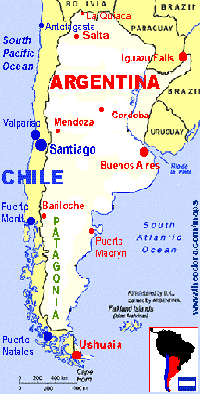 Laguna Brava Laguna Brava
-- Story by Erin --
Friday, May 10th: From Talampaya, our plan was to get as
close to Laguna Brava as possible and find a town to spend the night. The next day
we would make the trek to one of the highest salt lakes in the world at over 4,200 meters.
The road is a one-way trip to nowhere really, just the salt lake and a desolate
border crossing into Chile, which nearly no one uses. At 75 kilometers from the lake
the closest village was Jague (pronounced Hog-way in English). But staying there was
not an option as it's so small there is no hotel/hostel and the altitude makes it very
cold and windy at night. Camping would be tedious. The next closest village is
Vinchina, which is where we stayed in the only hotel in town. The town can best be
described as one very long main street. There are no side streets and the town seems
to go on forever.
The next morning we rose early. We knew it would be a
fairly arduous trip up to the lake and we could see that the wind was already starting to
pick up. The hotel let us store our panniers and luggage with them so that we could
keep the bikes light. It's a good thing we did! Straight away when we left
Vinchina we had a major river crossing. For the next 38 kilometers to Jague, the
road was a mixture of powdery slippery sand, small river crossings, and hard packed earth
and rocks, on a winding road through a deep canyon. That alone took us more than an hour
to ride. As we drove down the main street (same as Vinchina) we noticed that there
were curious high (maybe 4 meters) natural earthen walls (one can see tree roots sticking
out of them) on either side of the street. On top of these are plateaus on which the
buildings, trees, etc. stand. We later found out that the locals found this a useful
way to avoid getting flooded. It almost never rains there but when it does it rains
heavily for several hours. The main street then becomes a gushing 3-meter high
river, which channels the water out of town.
In Jague there is a ranger station where you register your
intentions and pay a small fee to enter the nature reserve. The friendly ranger
recognized us from a recent TV interview we had done in La Rioja and knew from the news
report that we were due to arrive on that day. Laguna Brava is so remote that they
don't see many visitors. In fact, that day it was only us and a Canadian woman with
an Argentine couple.
Thankfully there is a paved road for 35 kilometers on the
other side of Jague leading to the lake. We have no idea why they decided to pave
this particular stretch, but it was a nice respite from the pounding road leading to
Jague! After that we encountered another 40+ kilometers of jarring, steep and
winding road to the top. The views just got better and better as we climbed in
altitude. We reached an altitude of 4,395 meters/14,416 feet where the air was thin
but the wind incredible. The colors of the mountains changed from bright red to
white to black to green depending on their geological makeup. Dense green desert
bushes gave way to yellow tussock grass, then to barren rocky mountain plateau surrounding
the white salt of the lake. Along the way we passed small stone refuges in a shape
similar to an igloo. These were used in the early part of the 19th-century by
drivers of oxen on their way to Chile. The only animals we saw were several herds of
vicuņas (same family as the guanaco and llama). Pumas are supposedly abundant here,
however it is rare to ever see one.
The wind was so strong on the plateau that it was difficult
to carry a conversation with one another and to dismount the bikes. We passed the
other travellers in a Nissan 4x4 that we heard were up there and they happily snapped a
picture of us. The lake is in a crater, recently discovered to have been created by
a meteorite 4 kilometers in diameter. Surrounding the lake are 5 of some of the
highest volcanoes in the world (Veladero, Reclus, Los Gemelos, Bonete, and Pissis being
the highest in the world at 6,882 meters). It was a very strange feeling being
there, like you are the only human on earth. So little life exists in that
environment.
We didn't stay too long as the wind and cold made it
uncomfortable to ride or stand still. We gobbled a small package of cookies, which
served as our lunch and headed back down. When we arrived back to Vinchina it was
already past 5pm in the evening. It was a long, challenging and rewarding day.
I would definitely say that Laguna Brava makes the list (along with the Falls of
Iguazu and the Perito Moreno Glacier) of the top sites to see (if you can get there!) in
South America.
Main Street / River flood-way in pueblo of Jague
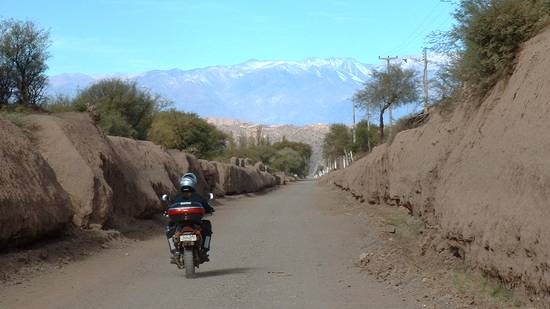
|
Heading up into the mountains
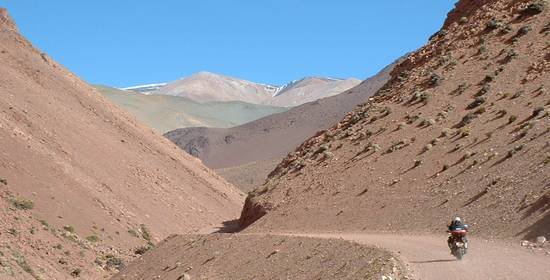
|
Crossing the 4,000 meter (13,120 ft) mark, and climbing....
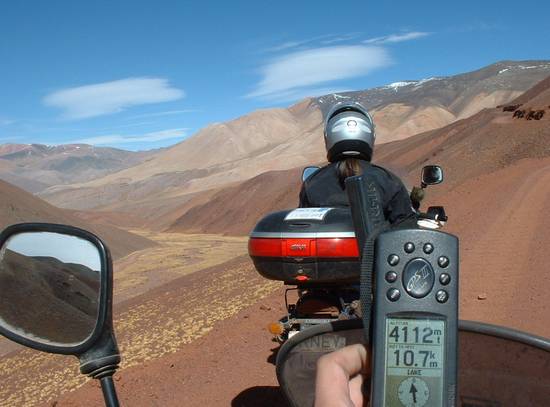
This is 13,487 feet
|
Nearing the highest lattitude so far -- 14,347 feet
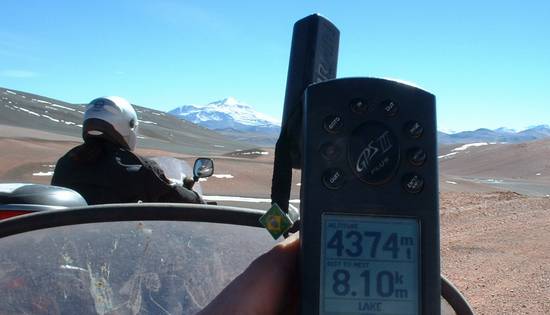
|
Windy as could be -- 5 meters short of the 4,400 mark
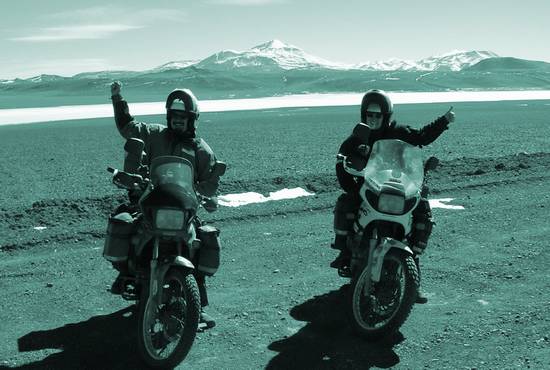
|
|